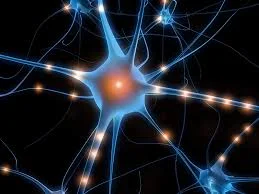What are neurotransmitters and what do they do?
Imagine sitting down in the doctor’s office for your yearly check-up and the doctor says
she is going to check your reflexes. She taps a reflex hammer to the bottom of your knee, causing
your leg to jerk upwards in reflex. “All good,” she says. But what exactly was she looking for
when she examined your reflexes? Was it to make sure your bottom half isn’t paralyzed? Or
perhaps to test how fast you can move in case of emergencies? Neither. In checking your
reflexes, the doctor is checking for a working peripheral and central nervous system. Essentially,
how well the signals travel through your peripheral nervous system (PNS) into your central
nervous system (CNS) from the point your leg is hit with the hammer to when you react.
The nervous system is upheld by chemical and electrical signals that transport messages
from one part of the body to another. Neurons are nerve cells that take on the job of transporting
the electric signals between each other. A neuron is composed of a cell body will small
projections called dendrites and a long projection called an axon. Dendrites, being close to the
cell body, are used for receiving signals from other nerve cells. The axon is used to sending
messages to other cells. At the end of the axon, where it approaches another cell, is the synaptic
terminal. It is called a terminal because it is the end of the electrical charge that passes through
the neuron to produce the signal. Electrical signals are sent within the neuron and chemical
signals are used between neurons and cells.
At the synaptic terminal, little chemical messengers called neurotransmitters enable
neurotransmission. An axon is often connected to a dendrite from another neuron in order to pass
the signal forward. That dendrite will then be called the postsynaptic area containing the synaptic
cleft. Here, receptors are found on the cell’s surface to receive the chemical signals coming out
of the axon terminal. Neurotransmitters are released when an action potential comes to the end of
the cell. These neurotransmitters are transported within a synaptic vesicle to the end of the cell
and out the cell membrane.
Once outside the cell, it is close enough to quickly bind to the receptors in the
postsynaptic cell membrane. The release of neurotransmitters into the next cell is completely
random, leading to multiple failures the smaller the synapse, such as those in the central nervous
system. Large synapses like the ones found between neurons and muscles (called neuromuscular
junction) are able to take more of the neurotransmitters. If the postsynaptic cell is a neuron, the
receptor opens ion channels within the membrane of the cell that changes the transmembrane
potential for a change in voltage. The receptor can inhibit (calm) or excite (stimulate) a response
in the next cell. The neurotransmitter does not stay in the postsynaptic cell, and only touches the
receptors for a bit, enough to pass on the signal. It is then released back into the synaptic
terminal, where it can do three things. 1) It can be taken by enzymes and metabolized back into
the presynaptic cell or 2) taken back up by the presynaptic cell through active transport in the
cell membrane or 3) diffuse to other parts outside the cells.
Neurotransmitters are the reason why our bodily processes occur so efficiently, and why
we never have to worry about not feeling a bug on our hand and process it quickly enough to
move our hands away (unless you don’t mind). They are the way signals are transmitted through
our bodies between neurons and work resourcefully to not miss its function. Neurons mostly give
off thousands of synapses, with some exceptions. Each of these synapses are sending
neurotransmitters back and forth. Now if you can imagine how many neurons and
neurotransmitters are at work while you are simply moving your eyes back and forth on this
page. Oh, what a world we live in!
References:
“Neurogistics.” What are Neurotransmitters? - Neurogistics,
www.neurogistics.com/the-science/what-are-neurotransmitters.
2. “Integrative Psychiatry.” The Four Major Neurotransmitters and the Neurotransmitter
Imbalances, www.integrativepsychiatry.net/neurotransmitter.html.



